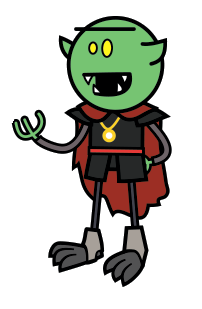
- Order of the stick monster in the darkness trial#
- Order of the stick monster in the darkness series#
- Order of the stick monster in the darkness free#
Order of the stick monster in the darkness series#
In a series of pseudo-anthropological articles published in Le Congo Illustré, Fiévez cataloged the customs and culture of the Equateur District. Not that any of this made it into the reams of marketing material put out by the CFS machine. After one expedition, Fiévez reported killing 1,346 people with “only 2,838 cartridges,” and devastating “162 villages, burn the houses and cut down the crops to reduce the population by hunger.” In return, the chiefs promised to “supply each month 1,562 portions of 15 kilos of rubber.” The district produced in 1895 more than 650 tons of rubber, bought at 25 centimes per kilo … and sold in Antwerp at 6 francs 50 centimes per kilo.” (That’s a markup of 2,500 percent, for the business-minded among you.) Of course, these incredible profits came at a price. The CFS’s Bulletin Officiel for June 1896 notes that “The results obtained by M. And none answered the call more emphatically than Fiévez. Leopold, who never once set foot in the Congo, wrote impassioned letters exhorting his men on the ground to send more and more rubber. When the world went crazy for rubber in the 1890s (John Boyd Dunlop’s invention of the bicycle tire was a catalyst), Leopold saw his opportunity to make his economically unsustainable private colony profitable. Rom, Hochschild reasoned, was - like Kurtz - a rounded individual who enjoyed painting, writing and butterfly collecting in addition to casual cruelty. Ultimately, Hochschild decided that Conrad was more likely inspired by Léon Rom, another young Belgian whose flower bed was bordered by a mere 22 heads on stakes. Fiévez had once boasted of “a hundred heads cut off at his orders,” notes Hochschild, whose research shows that Conrad’s steamboat almost certainly stopped for fuel at the heavily fortified post that Fiévez commanded. It turns out murdering your workforce is not a long-term solution.Īll of this has led Adam Hochschild, author of King Leopold’s Ghost, to wonder whether Fiévez was the real-life inspiration behind Kurtz - the central character in Joseph Conrad’s Heart of Darkness, who’s famous for his collection of (human) heads on stakes.
Order of the stick monster in the darkness trial#
He eventually faced trial for his excesses on two separate occasions - and although he was acquitted both times, he was forced out of the CFS in 1900. He wanted to see the number of hands cut off by each soldier, who had to bring them in baskets.” Tswambe described one of Fiévez’s subordinates drowning 10 natives in a net weighed down with stones.įiévez’s success was built on levels of cruelty that stood out - even by the brutal standards of the CFS. “From all the bodies killed in the field, you had to cut off the hands.

“All Blacks saw this man as the Devil of the Equator,” said Congo native Tswambe when describing Fiévez to the Catholic priest Edmond Boelaert some 45 years after Fiévez’s reign of terror. To natives of the region, he was a living nightmare.
Order of the stick monster in the darkness free#
He arrived in the Equateur District of the Congo Free State (CFS) in 1888 just three years after the king had founded it, and rose rapidly through the official ranks, lauded for the amount of rubber he was able to procure from his local subjects.


To King Leopold of Belgium, Léon Fiévez was a hero.


 0 kommentar(er)
0 kommentar(er)
